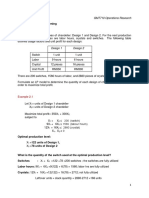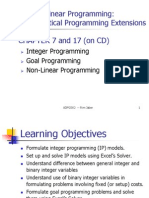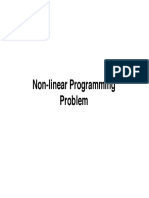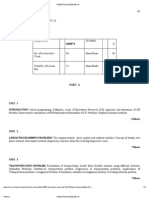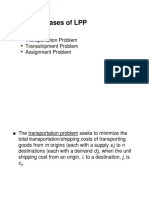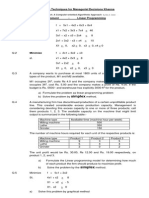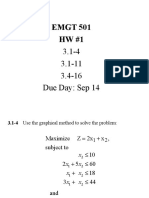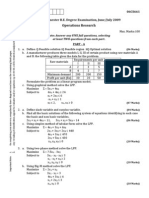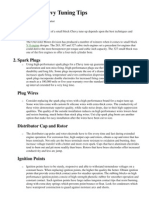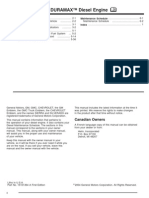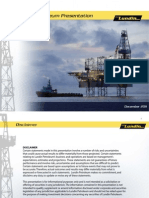Non Linear Programming
Uploaded by
rinkirola7576Non Linear Programming
Uploaded by
rinkirola7576Non linear Programming Problems
A nonlinear optimization programming problem is any optimization problem in which at least one term
(Decision Variable) in the objective function or a constraint is nonlinear.
Blending Problems
Blending problems arise whenever a manager must decide how to combine two or more ingredients in
order to produce one or more products. These types of problems occur frequently in the petroleum
industry (such as blending crude oil to produce different octane gasolines) and the chemical industry
(such as blending chemicals to produce fertilizers, weed killers, and so on). In these applications,
managers must decide how much of each resource to purchase in order to satisfy product specifications
and product demands at minimum cost.
Grand Strand Oil Company produces regular-grade and premium-grade gasoline products by blending
three petroleum components. The gasolines are sold at different prices, and the petroleum components
have different costs. The firm wants to determine how to blend the three components into the two
products in such a way as to maximize profits. Data available show that the regular-grade gasoline can
be sold for $2.90 per gallon and the premium-grade gasoline for $3.00 per gallon. The maximum
number of gallons available for the three components are 5000, 10,000 and 10,000, respectively. For the
current production-planning period, Grand Strand can obtain the three components at the costs of
$2.50, $2.60 and $2.84, respectively. The product specifications for the regular and premium gasolines,
shown in Table below, restrict the amounts of each component that can be used in each gasoline
product. Current commitments to distributors require Grand Strand to produce at least 10,000 gallons
of regular grade gasoline. The Grand Strand blending problem is to determine how many gallons of each
component should be used in the regular blend and in the premium blend. The optimal solution should
maximize the firms profit.
Product Specifications
Max Comp 1 30%
Regular Gasoline Max Comp 3 20%
Min Comp 2 40%
Min Comp 1 25%
Premium Gasoline Min Comp 3 30%
Max Comp 2 45%
You might also like
- 2008 Chevrolet Malibu Service Repair Manual PDF100% (1)2008 Chevrolet Malibu Service Repair Manual PDF19 pages
- (Ebook) - (Drugs) - (Methamphetamine) - (Nazi Labs) - (How To Make Crystal Meth)100% (4)(Ebook) - (Drugs) - (Methamphetamine) - (Nazi Labs) - (How To Make Crystal Meth)7 pages
- Video Lectures by Prof Madhusudan Sohani. Handout of Questions and NotesNo ratings yetVideo Lectures by Prof Madhusudan Sohani. Handout of Questions and Notes23 pages
- Management Lessons From Bollywood MoviesNo ratings yetManagement Lessons From Bollywood Movies24 pages
- Exam Advanced Linear Programming, May 14, 13.30-16.30No ratings yetExam Advanced Linear Programming, May 14, 13.30-16.304 pages
- Mixed-Integer Linear Programming (MILP) - MATLAB IntlinprogNo ratings yetMixed-Integer Linear Programming (MILP) - MATLAB Intlinprog15 pages
- Object-Oriented Programming, Functional Programming and RNo ratings yetObject-Oriented Programming, Functional Programming and R14 pages
- Problems On Linear Programming Formulations - Aug - 2013100% (1)Problems On Linear Programming Formulations - Aug - 201316 pages
- Decision Making Using The Analytic Hierarchy Process (AHP) A Step by Step ApproachNo ratings yetDecision Making Using The Analytic Hierarchy Process (AHP) A Step by Step Approach4 pages
- Assessment of Risk Management On Small and Micro Enterprises: Case Study On Some Selected Small and Micro Enterprises in Kezira Area100% (1)Assessment of Risk Management On Small and Micro Enterprises: Case Study On Some Selected Small and Micro Enterprises in Kezira Area23 pages
- Special Cases of LPP: Chapter 6, Part A: Distribution and Network ModelsNo ratings yetSpecial Cases of LPP: Chapter 6, Part A: Distribution and Network Models39 pages
- Computer Simulation and Applications in Life Sciences: Dr. Michael Emmerich & Dr. Andre Deutz LiacsNo ratings yetComputer Simulation and Applications in Life Sciences: Dr. Michael Emmerich & Dr. Andre Deutz Liacs37 pages
- Linear Programming: Simplex Method: Dr. R. K Singh Professor, Operations Management MDI, GurgaonNo ratings yetLinear Programming: Simplex Method: Dr. R. K Singh Professor, Operations Management MDI, Gurgaon58 pages
- IE 360 Engineering Economic Analysis: Name: Read The Following Instructions CarefullyNo ratings yetIE 360 Engineering Economic Analysis: Name: Read The Following Instructions Carefully11 pages
- PPT2 - W1-S2 - Simplex Method & Duality Theory-R0No ratings yetPPT2 - W1-S2 - Simplex Method & Duality Theory-R073 pages
- Operations Research: USN 06CS661 Sixth Semester B.E. Degree Examination, June/July 200933% (3)Operations Research: USN 06CS661 Sixth Semester B.E. Degree Examination, June/July 200923 pages
- Machinery Oil Analysis & Condition Monitoring : A Practical Guide to Sampling and Analyzing Oil to Improve Equipment ReliabilityFrom EverandMachinery Oil Analysis & Condition Monitoring : A Practical Guide to Sampling and Analyzing Oil to Improve Equipment Reliability3.5/5 (5)
- I Am . Game 2. Trash Your Ego 3. First Impressions 4. Balloons Games 5. Ego Scale AnalysisNo ratings yetI Am . Game 2. Trash Your Ego 3. First Impressions 4. Balloons Games 5. Ego Scale Analysis1 page
- A Farmer Grows Tomatoes and Peas On Her 125 Hectres Piece of Land100% (1)A Farmer Grows Tomatoes and Peas On Her 125 Hectres Piece of Land2 pages
- DiagnosticsProcedureOnPowerStroke6.0L 11.2010100% (1)DiagnosticsProcedureOnPowerStroke6.0L 11.20107 pages
- 2005DuramaxManual Like s10 Diesel Engines PDFNo ratings yet2005DuramaxManual Like s10 Diesel Engines PDF78 pages
- "6.0L Power Stroke Diagnostics": Technical Article67% (3)"6.0L Power Stroke Diagnostics": Technical Article4 pages
- 2000 Super Duty F-250, F-350, F-450, F-550 Owner Guide100% (7)2000 Super Duty F-250, F-350, F-450, F-550 Owner Guide256 pages
- (PDF) Octane Rating of Gasoline and Octane Booster AdditivesNo ratings yet(PDF) Octane Rating of Gasoline and Octane Booster Additives17 pages
- Indonesia - ASEAN MOST Prospect Commercial Vehicle and Heavy Duty Event 2018No ratings yetIndonesia - ASEAN MOST Prospect Commercial Vehicle and Heavy Duty Event 20183 pages
- Nse Indices - Industry Classification Structure 2023 07No ratings yetNse Indices - Industry Classification Structure 2023 0723 pages
- Structural Characterization of Saudi Arabian Heavy Crude Oil by N.M.R. SpectrosNo ratings yetStructural Characterization of Saudi Arabian Heavy Crude Oil by N.M.R. Spectros6 pages
- 155 Years of Artificial Lift: Pumping OilNo ratings yet155 Years of Artificial Lift: Pumping Oil7 pages
- Biswas 2001 Environmental Science & PolicyNo ratings yetBiswas 2001 Environmental Science & Policy12 pages
- Eaton® Lubricant Suppliers TCMT0020 EN-US: Lubrication Guide100% (1)Eaton® Lubricant Suppliers TCMT0020 EN-US: Lubrication Guide15 pages
- Pseudacris Regilla in The Dow's Prairie Educational Wetland: Exploring Possible Reasons Behind Pacific Chorus Frog Population DeclineNo ratings yetPseudacris Regilla in The Dow's Prairie Educational Wetland: Exploring Possible Reasons Behind Pacific Chorus Frog Population Decline80 pages
- EIA Report Augmentation and Revamping of LPGBP Salem TNNo ratings yetEIA Report Augmentation and Revamping of LPGBP Salem TN123 pages
- Using The Freedom of Information Act For Competitive Intelligence100% (2)Using The Freedom of Information Act For Competitive Intelligence11 pages
- A Presentation ON "Effectivness of Training Programme of Employees" AT Vimal Oil & Foods LTDNo ratings yetA Presentation ON "Effectivness of Training Programme of Employees" AT Vimal Oil & Foods LTD18 pages












